#konstantin pavlovich
Explore tagged Tumblr posts
Text

35 notes
·
View notes
Text
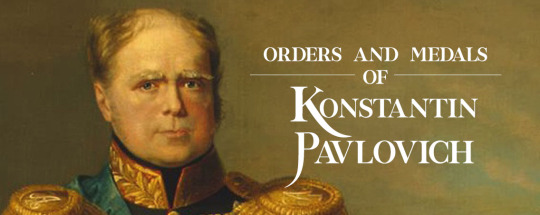

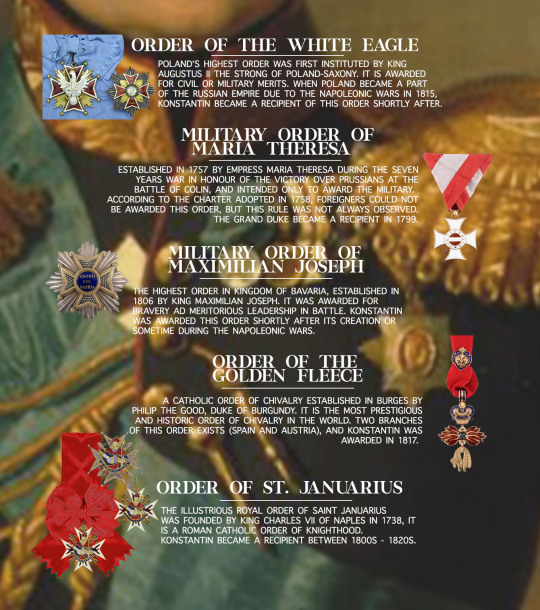
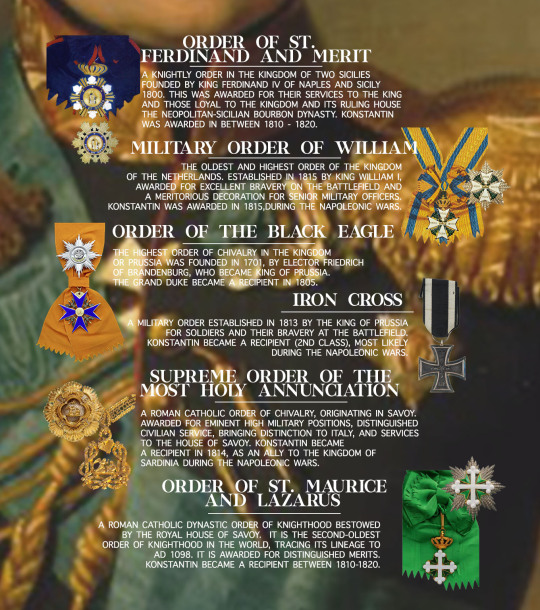
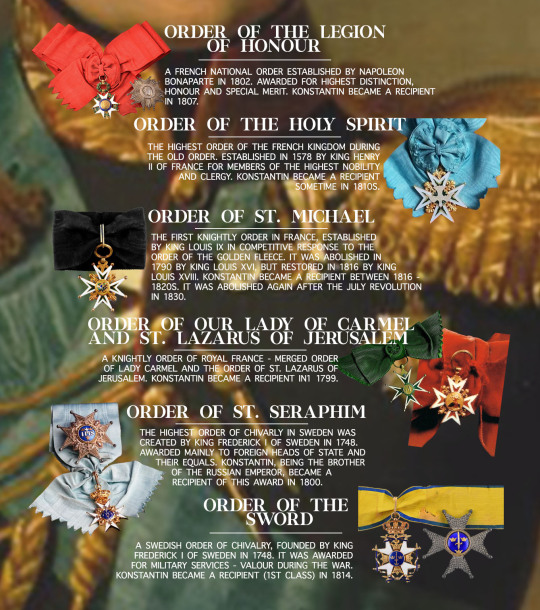
Orders and Medals → ɢʀᴀɴᴅ ᴅᴜᴋᴇ ᴋᴏɴꜱᴛᴀɴᴛɪɴ ᴘᴀᴠʟᴏᴠɪᴄʜ
Grand Duke Konstantin Pavlovich, the second son of Emperor Paul I of Russia, was recorded to have been a recipient of twenty-three awards. Seven nationals: Order of Saint Andrew, Order of Saint Alexander Nevsky, Order of St. Anna, Order of St. John Jerusalem, Order of St. George, Order of St. Vladimir, and Order of the White Eagle. And sixteen foreign: Military Order of Maria Theresa (Austria), Military Order of Maximilian Joseph (Bavaria), Order of the Golden Fleece (Spain), Order of St. Januarius (Naples), Order of Saint Ferdinand and Merit (Naples and Sicily), Military Order of William (The Netherlands), Order of the Black Eagle (Prussia), Iron Cross (Prussia), Supreme Order of the Holy Annunciation (Italy), Order of St. Maurice and Lazarus (Italy), Legion of Honour (France), Order of the Holy Spirit (France), Order of St. Michael (France), Order of Our Lady of Carmel and Saint Lazarus of Jerusalem (France), Order of Saint Seraphim (Sweden), and Order of the Sword (Sweden).
19 notes
·
View notes
Text
Every group got the

It's almost as if someone was missing. 🤔
#russian history#history#russian empire#alexander i of russia#napoleonic era#napoleonic wars#alexander i#historical shitpost#napoleonic shitpost#napoleonic memes#historical memes#grand duke konstantin pavlovich of russia#Grand duke Konstantin Pavlovich#nicholas i#Nicholas I of Russia#eugene of wurttemberg
67 notes
·
View notes
Text
On this day: July 18th 1918, The Bolsheviks took several Romanovs to a mine shaft in Alapaevsk and brutally murdered them. These victims were:
Grand Duchess Elisabeth Feodorovna, Grand Duke Sergei Mikhailovich, Prince Ioann Konstantinovich, Prince Konstantin Konstantinovich, Prince Igor Konstantinovich, and Vladimir Pavlovich Paley, along with nun, Varvara Yakovleva and Feodor Semyanovich Remez
Photos of the tragic dead bodies of the victims and other photos from the murder.
⚠️ !!!TRIGGER WARNINGS!!! ⚠️
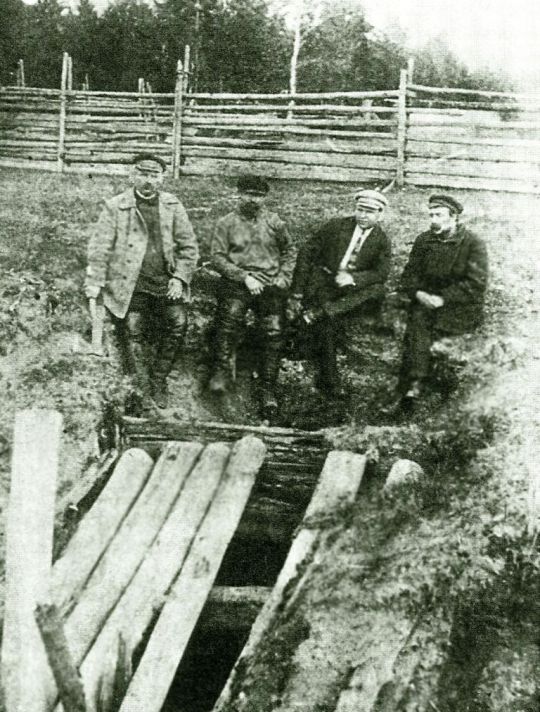
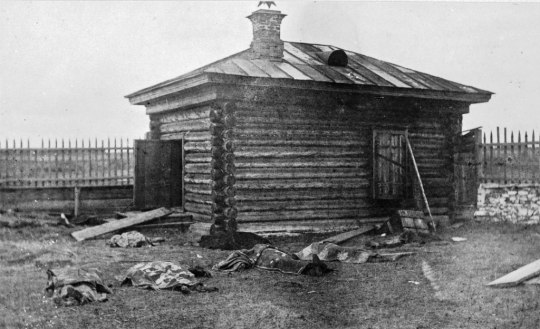
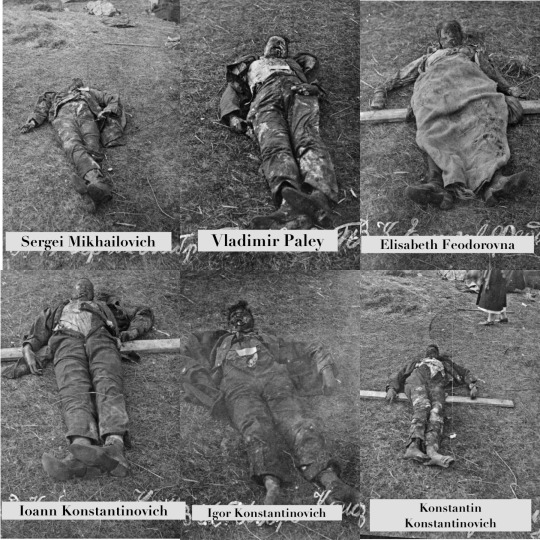
May their souls rest in peace ❤️🩹🕊️✨
#romanov#romanovs#alapaevsk#alapayevsk#elisabeth feodorovna#princess elisabeth of hesse#sergei mikhailovich#ioann konstantinovich#igor konstantinovich#konstantin konstantinovich#konstantinovichi#Vladimir Pavlovich Paley#1918#July 18
50 notes
·
View notes
Text

“The two eldest sons of Emperor Pavel I (Aleksandr and Konstantin) were terribly ugly because they physically resembled him, whereas the two youngest (Nikolay and Mikhail) were more beautiful because they did not resemble him physically.” - Submitted by Anonymous
#Paul I of Russia#Alexander I of Russia#Grand Duke Konstantin Pavlovich#Nicholas I#Grand Duke Michael Pavlovich
17 notes
·
View notes
Text
Jestem bardzo ciekawa, skąd tak szybko i w stresie znalazł sukienkę w swoim rozmiarze. Bo to jednak był kawał chłopa.
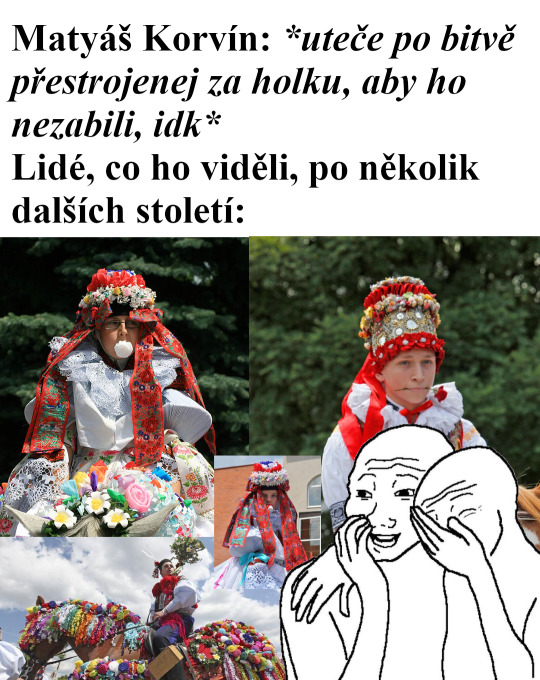
První středoevropská drag queen
(bitva-u-Uherského-Broducore) (zdroj: bylo mi to odhaleno ve snu)
#i will not stand for slandering my baby kostuś#chłop przebrany za babę#history#grand duke konstantin pavlovich
327 notes
·
View notes
Text

Grand Duke Mikhail Pavlovich of Russia (Russian: Михаи́л Па́влович) 8 February [O.S. 28 January] 1798– 9 September [O.S. 28 August] 1849. was a Russian grand duke, the tenth child and fourth son of Paul I of Russia and his second wife, Sophie Dorothea of Württemberg, who took the name Maria Feodorovna. He was the younger brother of two Tsars, Alexander I and Nicholas I, and the disputed Tsar Konstantin I.
#wikipedia#imperial russia#romanov#historical photos#russian imperial family#russian empire#russian history#sejarah#history
12 notes
·
View notes
Note
Hey I wonder, how many branches are there in the Romanov family, anyway?
It depends on how you want to divide them up!
Most historians tend to do it by the sons of Nicholas I, so we end up with: The Alexandrovichi - Alexander II and his descendants. This group is sometimes subdivided by Alexander II's sons, so we have the continuation of the Alexandrovichi with Alexander III, and then the Vladimirovichi (descendants of Vladimir Alexandrovich) and Pavlovich (descendants of Pavel Alexandrovich). I don't tend to label things as 'alexandrovichi' because they're the main line of the Imperial Family.
The Konstantinovichi - Descendants of Konstantin Nikolaevich. This can include the Greek Royal Family as their founding matriarch was Konstantin's daughter, Olga Konstantinovna. But usually people think of the poet Konstantin Konstantinovich (KR) and his many children.
The Nikolaevichi - descendants of Nikolai Nikolaevich Sr. He only had two children, Nikolai Nikolaevich Jr (Nikolasha) and Peter Nikolaevich, and of the two, only Peter had children of his own, so it's a small branch.
The Mikhailovichi - the descendants of Mikhail Nikolaevich. This includes Sandro, the husband of Nicholas II's sister Xenia, so her kids are technically part of the Mikhailovichi branch but you could argue they are Alexandrovichi through their mother. Also OTMAA's playmates Nina and Xenia Georgievna are in this branch.
Another major branch are the Leuchtenbergs, who are the descendants of Nicholas I's daughter Maria and her husband Maximilian of Leuchtenberg. They lived in Russia, were granted the style of Imperial Highness, and while their title was Prince/ss Romanovsky, they were essentially treated like Grand Dukes/Duchesses.
12 notes
·
View notes
Note
What was Tsar Nicholas's relationship with other Grand Dukes? Which one did he not like and which ones did he greatly respect and admire?
Assuming you mean Nicholas II:
Among his uncles, Nicholas was not very fond of Vladimir Alexandrovich, because the latter had a very forceful personality and intimidated Nicholas. They also had a great conflict over Kyril´s marriage, which resulted in Vladimir shouting at Nicholas and even tearing off his epaulettes and throwing them into the Tsar´s face.
With Grand Dukes Sergei and Pavel Nicky had a good relationship, especially because he was very fond of their wives, but Sergei was later murdered and Pavel, after the death of his first wife, married a commoner without Nicholas´ permission, thus earning exile and the relationship was pretty much completely severed, up until the revolution.
His favourite uncle was Grand Duke Alexei. We know him as a person who loved life and was pretty much useless when it came to doing any meaningful work, either in politics or Navy, in which he had the post, but he was funny, always kind to Nicholas and pretty much an antithesis to Vladimir. Tsarevich Alexei was named after him.
When it came to cousins and other Grand Dukes, with most of them nicholas had good and even close relationships when he was younger, but as the time went by and the Imperial family closed off themselves (because of Alexei´s hemophilia and other issues) from the rest of the Romanovs, most of those relationships deteriorated. Mikhail Alexandrovich and Kdyril Vladimirovich married without permission and pretty much against the family law. Boris and Andrei Vladimirovichi were good for nothings with loose morals. Sandro had distinctly different political (and other) views (and frankly suffered from a big head, especially in later years).
The favourite relatives, besides Grand Duke Alexei, who died in 1905, were Grand Duke Dmitri Pavlovich, whom both Nicholas and Alexandra, for the longest time, treated with great love and warmth , until the moment he involved himself with Rasputin´s murder, after which he pretty much ceased to exist to Alexandra and Nicholas had him banished (which ironically saved his life). The other great favourite was grand Duke Konstantin Konstantinovich (KR). His whole family remained close to the Tsar, his daughters being friends with OTMA, his sons serving during the war at the front and in the headquarters.
21 notes
·
View notes
Text
Grand Duchess Elizabeth was born Her Grand Ducal Highness Princess Elisabeth Alexandra Louise Alice of Hesse and by Rhine on November 1, 1864, the second child of Grand Duke Ludwig IV and his wife, born Princess Alice of Great Britain, a daughter of Queen Victoria. Princess Elizabeth married Grand Duke Sergei Alexandrovich, brother of Emperor Alexander III.
The young Grand Duchess was adored by the Imperial family and the Russian court for her beauty, kindness, and her ready adoption of Russian language, customs, and her ardent conversion to Orthodoxy.
Elizabeth and Serge moved to Moscow in 1894, when Serge was made Governor General of Moscow. Though Elizabeth had loved life in Saint Petersburg, it was not until her move to Moscow that began to see and understand what she was able to do for the less fortunate. She became very conscious of her role in helping the impoverished of Moscow, and sponsored benefits and charities in Moscow to help the poor and unfortunate.
In 1905, while driving through the Kremlin, an anarchist threw a bomb beneath her husband's carriage which exploded, tearing him to pieces, and killing him instantly.
Elizabeth remained in mourning, and in 1909, she took the veil and founded the Convent of Martha and Mary in Moscow. Elizabeth sold or gave away all her jewelry and possessions and assembled the funds to build the convent. The convent grew, and even during her lifetime, the Grand Duchess was called a saint by the poor of the capital. The convent, based on old Novgorod models, was an architectural jewel.
The convent grew and prospered until the Revolution. By 1918, her presence was finally no longer tolerated by the Revolutionary government, and she was arrested. They then exiled her first to Perm, then to Yekaterinburg, where she spent a few days and was joined by others: the Grand Duke Sergei Mikhailovich Romanov; Princes Ioann Konstantinovich, Konstantin Konstantinovich, Igor Konstantinovich and Vladimir Pavlovich Paley; Grand Duke Sergei’s secretary, Feodor Remez; and Varvara Yakovleva, a sister from the Grand Duchess’s convent. They were all taken to Alapaevsk on May 20, 1918, where they were housed in the Napolnaya School on the outskirts of the town.
On the night of July 17th, the prisoners were woken and driven in carts on a road leading to the village of Siniachikha. Some 18 kilometres from Alapaevsk there was an abandoned iron mine with a pit, twenty metres deep. The Cheka beat all the prisoners before throwing their victims into this pit, Elizabeth being the first. Hand grenades were then hurled down the shaft.
On October 8, 1918, the White Army discovered the remains of Elizabeth and her companions, still within the shaft where they had been murdered. Elizabeth had died of wounds sustained in her fall into the mine, but had still found strength to bandage the head of the dying Prince Ioann. Her remains were removed and ultimately taken to Jerusalem, where they lie today in the Church of Mary Magdalene.
Elizabeth was glorified by the Russian Orthodox Church Outside of Russia in 1981, and by the Patriarchal Russian Orthodox Church in 1992 as the New-Martyr Elizabeth. Her principal shrines are the Marfo-Mariinsky Convent, and the St. Mary Magdalene Convent on the Mount of Olives, which she and her husband helped build, and where her relics (along with the Nun Barbara) are enshrined. The convent was returned to the church and reopened in 1992 and the cathedral church in 2006, continuing St. Elizabeth’s work.
On this day, 105 years ago, on July 18th, 1918.
Grand Duchess Elisabeth Feodorovna was murdered by being thrown down a disused mine shaft in Siniachikha, Russia.
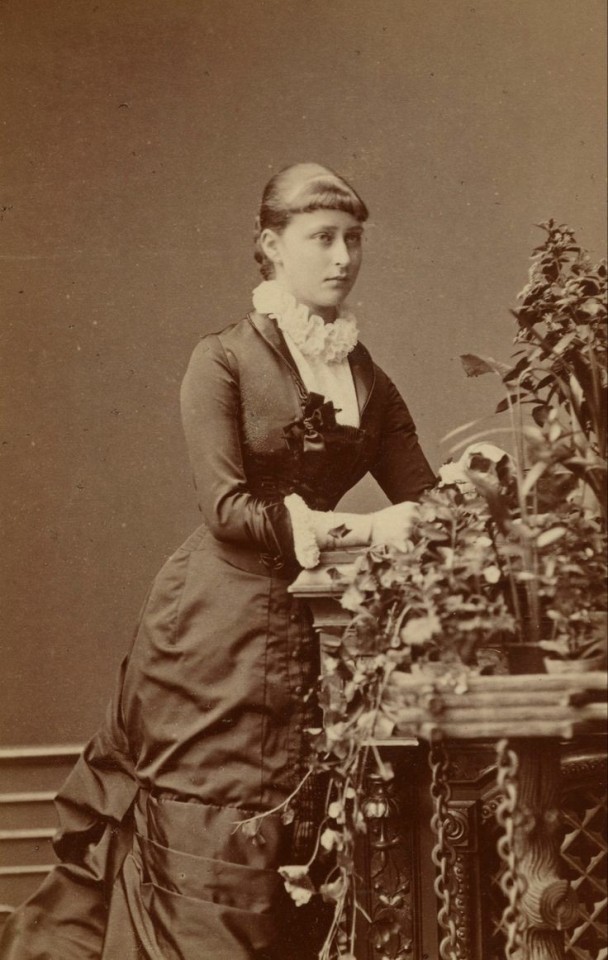

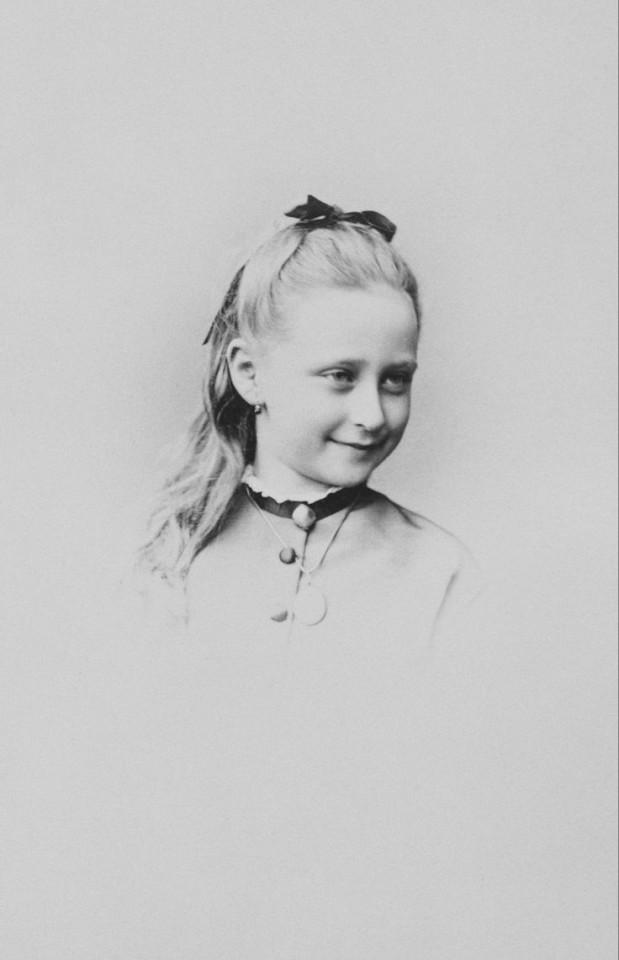






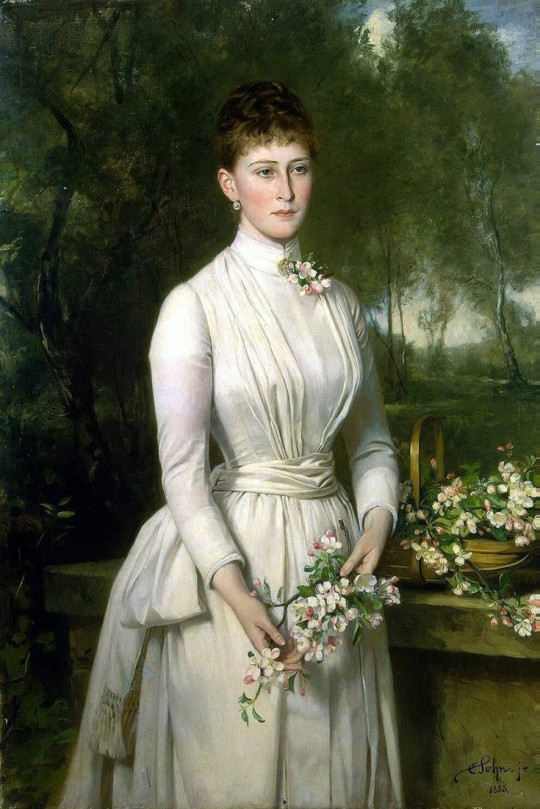
#russian history#romanov dynasty#Grand Duchess Elizabeth Feodorovna#Grand Duke Sergei Mikhailovich#Prince Vladimir Pavlovich Paley#Prince Ioann Konstantinovich#Prince Konstantin Konstantinovich#Prince Igor Konstantinovich#Feodor Remez#Barbara Yakolevna#Saint Mary Magdalene Convent#Alapaevsk
66 notes
·
View notes
Text
Women of Imperial Russia: Ages at First Marriage
I have only included women whose birth dates and dates of marriage are known within at least 1-2 years, therefore, this is not a comprehensive list. This data set ends with the Revolution of 1917.
Eudoxia Lopukhina, wife of Peter I; age 20 when she married Peter in 1689 CE
Catherine I of Russia, wife of Peter I; age 18 when she married Johan Cruse in 1702 CE
Anna of Russia, daughter of Ivan V; age 17 when she married Frederick William Duke of Courland and Semigallia in 1710 CE
Anna Petrovna, daughter of Peter I; age 17 when she married Charles Frederick I, Duke of Holstein-Gottorp, in 1725 CE
Catherine II, wife of Peter III; age 16 when she married Peter in 1745 CE
Natalia Alexeievna, wife of Paul I; age 17 when she married Paul in 1773 CE
Maria Feodorovna, wife of Paul I; age 17 when she married Paul in 1776 CE
Elizabeth Alexeivna, wife of Alexander I; age 14 when she married Alexander in 1793 CE
Anna Feodorovna, wife of Konstantin Pavlovich; age 15 when she married Konstantin in 1796 CE
Alexandra Pavlovna, daughter of Paul I; age 16 when she married Archduke Joseph of Austria in 1799 CE
Elena Pavlovna, daughter of Paul I; age 15 when she married Frederick Louis, Duke of Mecklenburg-Schwerin in 1799 CE
Maria Pavlovna, daughter of Paul I; age 18 when she married Charles Frederick, Grand Duke of Saxe-Weimar-Eisenach in 1804 CE
Catherine Pavlovna, daughter of Paul I; age 21 when she married Duke George of Oldenburg in 1809 CE
Anna Pavlovna, daughter of Paul I; age 21 when she married William II of the Netherlands in 1816 CE
Alexandra Feodorovna, wife of Nicholas I; age 19 when she married Nicholas in 1817 CE
Joanna Grudzinska, wife of Konstantin Pavlovich; age 29 when she married Konstantin in 1820 CE
Elena Pavlovna, wife of Mikhail Pavlovich; age 17 when she married Mikhail in 1824 CE
Maria Nikolaevna, daughter of Nicholas I; age 20 when she married Maximilian de Beauharnais, Duke of Leuchtenberg, in 1839 CE
Maria Alexandrovna, wife of Alexander II; age 17 when she married Alexander in 1841 CE
Elizaveta Mikhailovna, daughter of Mikhail Pavlovich; age 17 when she married Adolphe, Grand Duke of Luxembourg, in 1844 CE
Alexandra Nikolaevna, daughter of Nicholas I; age 19 when she married Prince Frederick-William of Hesse-Kassel, in 1844 CE
Olga Nikolaevna, daughter of Nicholas I; age 24 when she married Charles I of Wurttemberg, in 1846 CE
Alexandra Iosifovna, wife of Konstantin Nikolaevich; age 18 when she married Konstantin in 1848 CE
Catherine Mikhailovna, daughter of Mikhail Pavlovich; age 24 when she married Duke Georg August of Mecklenburg-Strelitz, in 1851 CE
Alexandra Petrovna, wife of Nicholas Nikolaevich the Elder; age 18 when she married Nicholas in 1856 CE
Olga Feodorovna, wife of Michael Nikolaevich; age 18 when she married Michael in 1857 CE
Maria Feodorovna, wife of Alexander III; age 19 when she married Alexander III in 1866 CE
Olga Konstantinovna, daughter of Konstantin Nikolaevich; age 16 when she married George I of Greece in 1867 CE
Vera Konstantinovna, daughter of Konstantin Nikolaevich; age 20 when she married Duke Eugen of Wurttemberg in 1874 CE
Maria Pavlovna, wife of Vladimir Alexandrovich; age 20 when she married Vladimir in 1874 CE
Maria Alexandrovna, daughter of Alexander II; age 19 when she married Alfred, Duke of Edinburgh, in 1874 CE
Anastasia Mikhailovna, daughter of Michael Nikolaevich; age 19 when she married Friedrich Franz III, Duke of Mecklenburg-Schwerin in 1879 CE
Nadezhada Alexandrovna Dreyer, wife of Nicholas Konstantinovich; age 21 when she married Nicholas in 1882 CE
Elizabeth Feodorovna, wife of Sergei Alexandrovich; age 20 when she married Sergei in 1884 CE
Olga Valerianovna Paley, wife of Paul Alexandrovich; age 19 when she married Erich von Pistolhkors in 1884 CE
Elizabeth Mavrikievna, wife of Konstantin Konstantinovich; age 19 when she married Konstantin in 1885 CE
Anastasia of Montenegro, wife of Nicholas Nikolaevich the Younger; age 21 when she married George Maximilianovich, Duke of Leuchtenberg in 1889 CE
Milica of Montenegro, wife of Peter Nikolaevich; age 23 when she married Peter in 1889 CE
Alexandra of Greece and Denmark, wife of Paul Alexandrovich; age 19 when she married Paul in 1889 CE
Sophie Nikolaievna, wife of Michael Mikhailovich; age 23 when she married Michael in 1891 CE
Victoria Feodorovna, wife of Kirill Vladimirovich; age 18 when she married Ernest Louis, Grand Duke of Hesse, in 1894 CE
Xenia Alexandrovna, wife of Alexander Mikhailovich; age 19 when she married Alexander in 1894 CE
Alexandra Feodorovna, wife of Nicholas II; age 22 when she married Nicholas in 1894 CE
Olga Alexandrovna, daughter of Alexander II; age 18 when she married Count George-Nicholas von Merenberg in 1985 CE
Maria of Greece and Denmark, wife of George Mikhailovich; age 24 when she married George in 1900 CE
Alexandra von Zarnekau, wife of George Alexandrovich; age 16 when she married George in 1900 CE
Catherine Alexandrovna, daughter of Alexander II; age 23 when she married Alexander Baryatinksy in 1901 CE
Olga Alexandrovna, daughter of Alexander III; age 19 when she married Duke Peter Alexandrovich of Oldenburg
Elena Vladimirovna, daughter of Vladimir Alexandrovich; age 20 when she married Prince Nicholas of Greece and Denmark in 1902 CE
Natalia Brasova, wife of Michael Alexandrovich; age 22 when she married Sergei Mamontov in 1902 CE
Elisabetta di Sasso Ruffo, wife of Andrei Alexandrovich; age 31 when she married Alexander Alexandrovitch Frederici in 1907 CE
Maria Pavlovna, daughter of Paul Alexandrovich; age 18 when she married Prince Wilhelm of Sweden in 1908 CE
Helen of Serbia, wife of Ioann Konstantinovich; age 27 when she married Ioann in 1911 CE
Tatiana Konstantinovna, daughter of Konstantin Konstantinovich; age 21 when she married Konstantine Bagration of Mukhrani, in 1911 CE
Irina Alexandrovna, daughter of Alexander Mikhailovich; age 19 when she married Felix Felixovich Yusupov in 1914 CE
Nadejda Mikhailovna, daughter of Michael Mikhailovna; age 20 when she married George Mountbatten in 1916 CE
Antonina Rafailovna Nesterovkaya, wife of Gabriel Konstantinovich; age 27 when she married Gabriel in 1917 CE
Nadejda Petrovna, wife of Nicholas Orlov; age 19 when she married Nicholas in 1917 CE
Anastasia Mikhailovna, daughter of Michael Mikhailovna; age 25 when she married Sir Harold Wernher in 1917 CE
59 women; average age at first marriage was 20 years old. The oldest bride was 31 at her first marriage; the youngest was 14.
15 notes
·
View notes
Text
Romanovs family chat

#russian history#history#russian empire#alexander i of russia#napoleonic era#napoleonic wars#alexander i#historical shitpost#napoleonic shitpost#grand duke konstantin pavlovich of russia#Grand duke Konstantin Pavlovich#Nicholas I#Nicholas I of Russia#historical memes#romanovs
68 notes
·
View notes
Text

Nicholas and his daughters with Konstantin Dmitrievich Nilov and Nikolai Pavlovich Sablin.
14 notes
·
View notes
Text
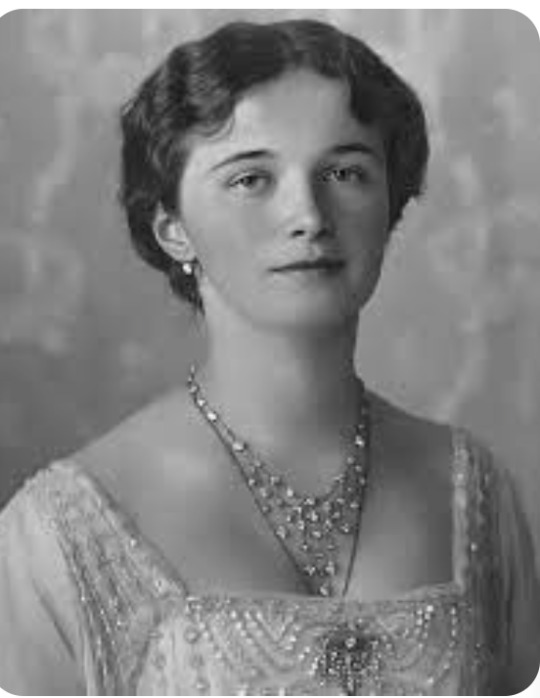
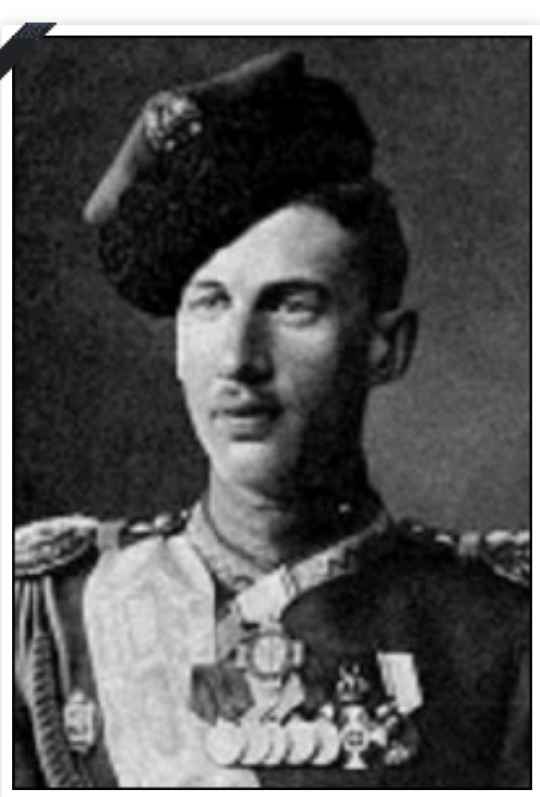
Grand Duchess Olga Nikolaevna and Prince Ioann Konstantinovich
Everybody knows by now that my favorite Romanov changes just about every week. Probably the one I "favor" most frequently is Grand Duchess Olga Nikolaevna. My heart goes out to her. In the time and place where she lived, a twenty-three-year-old girl was frequently already married and had children. Olga had to watch these and many other experiences pass her by from her captivity in Tobolks and Ekaterinburg. They say Olga was thin, withdrawn, sad, and did not seem to be coping as well as the other girls with the imprisonment. I think that Olga's "denial mechanism" was not working as well as that of the others, and she strongly suspected what was coming.
Enough of that....several names floated about (none of them seriously) as matrimonial prospects for Olga, such as that of her cousins Grand Duke Dmitry Pavlovich and Grand Duke Boris Vladimirovich. Prince Christopher of Greece and Denmark had expressed interest. Carol II of Romania had been considered. And then there was another, which I really liked for her (you may not): Prince Ioann (Ioannshick) Konstantinovich, the first-born son of Grand Duke Konstantine Konstantinovich and Grand Duchess Elizabeth Mavrikievna.
The following is a letter from Grand Duke Konstantine to his son when Ioann apparently mentioned the matter to him (not for the first time):
3 December, 1910. Pavlovsk. From bruderschaft [brotherhood, German], you very unexpectedly suddenly turn to Lubochka. You cannot marry her at this point, but without breaking the law, with which you need to familiarize yourself, taking advantage of conversations between AAs. Makarov and Kostya. During one of these conversations, ask for the federal secretary to explain to you the legalization of marriages of the members of the Imperial family. The Tatiana question has not been resolved by far, as it needs a change of the existing law. But let’s assume that it will be changed: then I advise you to be careful. Last year, you wrote to me about your love for Olga Nikolaevna and for Tanya and someone else, and now it’s Lubochka while you are still bringing up Olga Nikolaevna as well. Seems like you do not know yourself with whom specifically you are in love, but without a tested and faithful love, one should not marry.
Ioann was at that age when we fell in love every other day. He did ask the Tsar, who dismissed the idea by not taking the matter seriously, and told Ioann that his daughter was too young (in 1910, Olga would have been 15). The Empress had never liked the Konstantinovichi as potential grooms for her daughters because of their "poor health." Other than that, they were one of the few Grand Duccal families Alix liked.
Ioann married Helen of Serbia in 1911. He fought in WWI, had two children, and was eventually murdered by the Bolsheviks at Alapaevsk in the Urals (along with several other Romanovs, at least one of whom was his brother.) He was 32 years old. Olga died with her family not far from where he was killed, in Ekaterinburg at the age of 23.(gcl)
#russian history#romanov dynasty#imperial russia#nicholas ii#vintage photography#Grand Duchess Olga Nikolaevna#Princess Ioann Konstantinovich#Grand Duke Konstantin Konstantinovich
22 notes
·
View notes
Text

Portrait of Paul I, Maria Feodorovna and their Children
Artist: Franz Gerhard von Kugelgen (German, 1772-1820)
Date: c. 1800
Medium: Oil on Canvas
Collection: Private Collection
Portrait of Paul I, Maria Feodorovna and their Children
The imperial family is depicted against the backdrop of Pavlovsk Park. On the right in the background is the façade of the Pavlovsk Palace, facing the Slavyanka River.
The painting depicts, from left to right: Grand Prince Alexander Pavlovich in the uniform of the Life Guards Semyonovsky Regiment, leaning on a pedestal with a bust of Peter I; next to him stands Grand Prince Konstantin Pavlovich in the uniform of the Life Guards Cavalry Regiment; further on, little Grand Prince Nikolai Pavlovich is leaning against the knees of his mother, Empress Maria Feodorovna. Behind the figure of the seated Empress stands Grand Princess Ekaterina Pavlovna, and in the center of the composition, behind the harp, is Grand Princess Maria Pavlovna. Behind her, in the shade of the trees, is a column with a bust of Grand Princess Olga Pavlovna, who died in infancy. Further on, leaning on the knees of Emperor Paul I (in the uniform of the Preobrazhensky Regiment), stands the youngest daughter, Grand Princess Anna Pavlovna. At the foot of the chair on the ground sits a child - Grand Duke Mikhail Pavlovich. At the right edge of the painting stand Grand Dukes Alexandra and Elena Pavlovna.
The anachronism in the depiction of the uniforms of Alexander and Constantine is striking. Their tailcoat cut with a very high standing collar, open in the front, was introduced by Alexander I only in 1801. The innovation in the cut is easy to detect when comparing the uniform of the eldest sons with the suit of Paul I. This circumstance indicates that the "Family Portrait" was partially rewritten by the artist after the death of Paul I. In the handwritten Catalogue of the Paintings of the Pavlovsk Palace, compiled in 1925 by V. Zubov, there is an indication that this incongruity was noted by Emperor Alexander II. When examining the painting in infrared rays, it was discovered that the painting was indeed rewritten, and initially the uniforms of Alexander and Constantine looked different.
#group portrait#paul I of russia#maria feodorovna#sophie dorothea of wurttemberg#landscape#oil on canvas#russian empire#russian monarchy#full length#family portrait#men#women#children#chairs#trees#bust#harp#costume#conversation piece#franz gerhard von kugelgen#german painter#russian culture#early 19th century painting
2 notes
·
View notes
